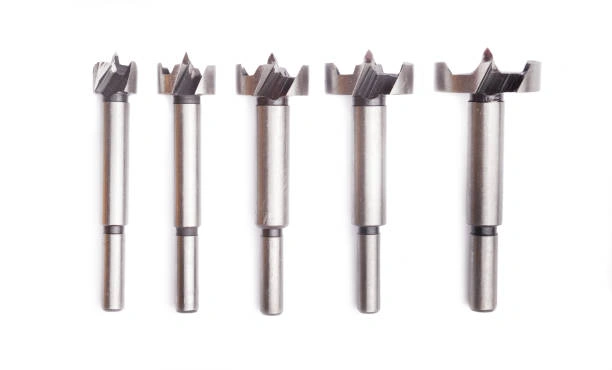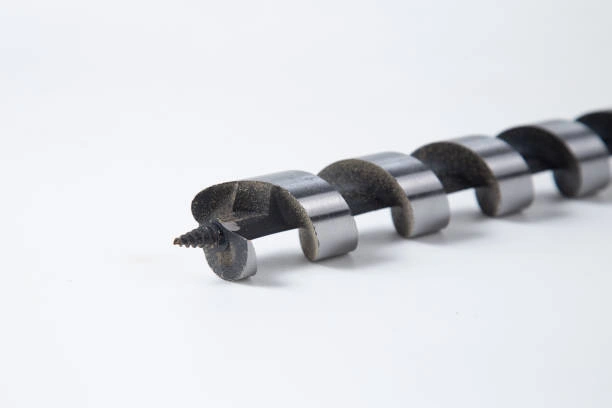As woodworkers, we constantly encounter various joinery techniques, each requiring specific tools for precision and strength. One such technique involves creating perfectly square holes, and for this, a specialized tool comes into play: the auger square drill bit. But what is an auger square drill bit used for exactly? Unlike the round holes created by twist drill bits, these unique bits are designed to cut precise square or rectangular mortises, essential for creating strong and tight mortise and tenon joints. In this comprehensive guide, we’ll explore the anatomy, applications, and advantages of these indispensable woodworking tools.
What is an Auger bit?

An auger bit stands out as a specialized drill bit predominantly engineered for boring deep and clean holes in timber. Its defining characteristic is a screw-threaded tip, often called a “worm” or “pilot screw,” which actively draws the bit into the wood as it rotates. This self-feeding action minimizes the manual pressure we need to apply, making deep drilling more manageable.
The main body of an auger bit features broad, spiraling channels known as flutes. These flutes are crucial for the efficient removal of wood chips and shavings from the borehole. This effective waste evacuation prevents the bit from clogging, ensuring continuous and smooth progress even when drilling to considerable depths. Auger bits are favored for their ability to produce relatively neat holes with less tearing or splintering of the wood surface compared to some other wood-boring bits.
Common Auger Sizes
Auger drill bits come in a wide range of sizes to suit various project needs, from compact handheld options to heavy-duty ground bits for larger tasks. In most hardware stores, you’ll typically find auger drill bits in the following common diameters: 4 inches, 6 inches, 8 inches, 12 inches, and 18 inches. As for their depth, standard auger bits usually range from 2 to 4 feet, though some specialized models can accommodate extended widths and depths for more demanding applications.
It’s important to note that a drill bit’s performance hinges on the compatibility with your drill, so be sure to select a drill that’s specifically designed to work best with auger bits for optimal results.
Benefits of Using an Auger Drill Bit

1. Efficient Deep Hole Drilling
The prominent screw tip, or worm, on an auger bit actively pulls it into the wood. This self-feeding action requires significantly less manual pressure compared to standard twist bits, making the task of drilling deep holes much easier and more efficient. We can achieve greater depths with less effort and fatigue, especially in thicker pieces of timber.
2. Effective Chip Removal
Auger bits feature wide, deep flutes that are specifically designed for excellent chip evacuation. As the bit bores into the wood, these flutes efficiently channel shavings and debris out of the hole. This prevents clogging, reduces friction and heat buildup, and allows for continuous, smooth drilling progress, even in sticky or resinous woods.
3. Creates Cleaner Holes
The cutting action of a sharp auger bit tends to produce cleaner holes compared to some other wood-boring bits, like spade bits. The defined cutting edges shear the wood fibers more cleanly, resulting in less splintering or tearing around the entry and exit points of the hole. This is particularly important for projects where a neat finish is desired.
4. Enhanced Accuracy and Control
The self-feeding action provided by the lead screw helps to keep the auger bit tracking straight and true. Once the screw engages, the bit is less likely to wander or “walk” across the surface of the wood. This enhanced control allows us to drill more accurate holes in the precise locations we intend, which is crucial for joinery and other detailed woodworking tasks.
5. Durability for Woodworking
Auger bits are typically constructed from high-carbon steel, which provides good durability for woodworking applications. When properly maintained and used correctly, they can withstand repeated use and maintain their sharpness for a considerable time. This makes them a reliable and long-lasting investment for any serious woodworker’s toolkit.
It seems there might be a slight mix-up in the keywords. In our previous conversation, the focus was on “What is HSS Titanium Drill Bits?”. Now, the target keyword is “What is an Auger Square Drill Bit Used For?”. To provide the most helpful and SEO-friendly article, we should focus on this new keyword.
What is an Auger Square Drill Bit Used For

As woodworkers, we constantly encounter various joinery techniques, each requiring specific tools for precision and strength. One such technique involves creating perfectly square holes, and for this, a specialized tool comes into play: the auger square drill bit. But what is an auger square drill bit used for exactly? Unlike the round holes created by twist drill bits, these unique bits are designed to cut precise square or rectangular mortises, essential for creating strong and tight mortise and tenon joints. In this comprehensive guide, we’ll explore the anatomy, applications, and advantages of these indispensable woodworking tools.
The Unique Design of an Auger Square Drill Bit
To understand what an auger square drill bit is used for, we first need to examine its distinctive design. Unlike a standard twist drill bit with spiral flutes, an auger square drill bit features a square or rectangular cutting head with sharp edges or spurs. This cutting head is attached to a shank, often with a screw or worm at the very tip. This screw helps to pull the bit into the wood, requiring less downward pressure from us.
The key to its square-cutting ability lies in the interaction between the outer square-cutting edges and often an inner chisel or cutter. As the bit rotates, the outer edges score the perimeter of the square, while the inner mechanism removes the waste material. Different designs exist, but the fundamental principle of creating a square or rectangular opening remains consistent. So, when we ask what an auger square drill bit is used for, the answer is intrinsically linked to its square cutting geometry.
The Primary Application: Creating Mortises for Joinery
The primary answer to what an auger square drill bit is used for is the creation of mortises. A mortise is a rectangular cavity cut into a piece of wood to receive a tenon, which is a projecting tongue on another piece of wood. The mortise and tenon joint is a time-honored and incredibly strong method of joining wood, used in everything from furniture making to timber framing.
Using an auger square drill bit allows us to create these mortises quickly and with a high degree of accuracy. The square shape of the hole ensures a snug fit for the tenon, maximizing the strength and stability of the joint. Without these specialized bits, creating perfectly square mortises would be a much more laborious and time-consuming process, often involving chisels and meticulous manual work. Therefore, understanding what an auger square drill bit is used for is fundamental to understanding efficient mortise and tenon joinery.
The Role of the Mortising Machine
While an auger square drill bit itself is the cutting tool, it’s typically used in conjunction with a mortising machine (also known as a mortiser or square chisel mortiser). This machine is specifically designed to hold the workpiece securely and drive the square drill bit straight down into the wood with controlled force.
The mortising machine features a chuck that accepts the shank of the auger square drill bit, and a system (usually a lever or handwheel) to apply downward pressure. Many mortising machines also have a fence and hold-downs to ensure the workpiece remains stationary and the mortise is cut in the desired location. So, when considering what an auger square drill bit is used for, it’s important to recognize its role as an attachment for a specialized machine.
Are There Different Types of Auger Square Drill Bits?
While the fundamental principle remains the same, there can be variations in auger square drill bits:
- Solid Square Chisels: These are one-piece bits where the square cutting edge and the shank are a single unit. They are common for smaller mortises.
- Hollow Chisel Mortise Bits: These consist of a square hollow chisel that fits over an internal auger bit. The auger removes the bulk of the waste, and the sharp edges of the hollow chisel shear the sides to create the square mortise. This type is very common and efficient.
- Spiral Flute Square Drill Bits: Some variations incorporate spiral flutes within the square body to aid in chip ejection, especially for deeper mortises.
Understanding these variations helps us choose the right auger square drill bit for our specific mortising machine and the demands of our project.
Beyond Mortises: Are There Other Uses?
Generally, their unique square cutting geometry limits them to this specific task. We wouldn’t typically use them for drilling standard round holes or other common drilling tasks. Their design is optimized for plunging straight down and creating a square or rectangular cavity. Therefore, when we think of what an auger square drill bit is used for, mortise creation remains the central and almost exclusive application.
Choosing the Right Auger Square Drill Bit

Selecting the correct auger square drill bit depends on several factors:
- Size of the Mortise: Square drill bits come in various sizes, corresponding to the desired width of the mortise. We need to match the bit size to our project requirements.
- Shank Diameter: The shank of the bit must be compatible with the chuck of our mortising machine.
- Type of Wood: Harder woods may require sharper, higher-quality bits.
- Depth of the Mortise: Longer mortises may benefit from bits with better chip ejection.
Considering these factors will help us choose the most effective auger square drill bit for our woodworking needs.
Conclusion
In summary, auger square drill bits are workhorses for woodworkers and DIY enthusiasts alike. Their unique design—square shank, screw point, and wide paddle—makes them perfect for deep, clean holes in various woodworking applications, from furniture making to home repairs. By understanding their uses and following best practices, you can tackle projects more efficiently and achieve professional results every time. Click on our homepage for more relevant information.


